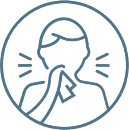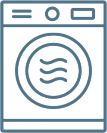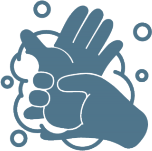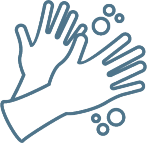Expanding Food Safety Protocols in an Evolving Landscape of COVID-19
ID
FST-373NP
Introduction
On April 9, 2020, a webinar was presented on how the novel coronavirus, SARS-CoV2, impacts food safety practices along the farm to fork continuum, focusing primarily on production and processing practices (Chase et al., 2020a,b,c,d). This factsheet provides answers to questions discussed and posed during the webinar. We will briefly look at what we know about SARS-CoV2 behavior, such as how it is transmitted, its viability, its inactivation, and then provide recommendations for food-based businesses.
Coronaviruses
What Causes COVID-19?
Human coronaviruses were first identified in the mid- 1960s. There are several types of coronaviruses that commonly cause respiratory illnesses in humans. There are also a number of animal coronaviruses. However, coronaviruses that have jumped from an animal species to humans has led to the emergence of Severe Acute Respiratory Syndrome (SARS) that first occurred back in early 2000, and a second type of SARS (COVID-19) that emerged in late 2019. In terms of nomenclature, COVID-19 refers to the illness experienced by infected persons, and the acronym stands for the novel 2019 coronavirus disease. The virus itself is referred to as SARS- CoV2, or Severe Acute Respiratory Syndrome Coronavirus 2, and this is the virus that causes the COVID-19 illness.
How is SARS-CoV2 Transmitted?
Understanding how the virus is transmitted is important for intervention and prevention of further illnesses, both in public life and also for employees and others in food production and processing situations. The Centers for Disease Control and Prevention (CDC) believes the virus is primarily transmitted from person to person through aerosolized droplets. When an infected person is coughing or sneezing or just breathing, the virus particles come out into the air space, and then other people can breathe those in and become sick. A secondary way is from touching contaminated surfaces.

What is the longest distance the virus can spread?
MIT conducted a study saying that a virus could spread over 20 feet and linger in the air for up to a couple of hours. Although there have been no studies on gas cloud droplet spread from individuals infected with SARS-CoV2, researchers at MIT have estimated, based on earlier fluid dynamics studies, that viruses my reach peak exhale speeds of 33-100 feet/second, and the resulting “cloud” of droplets containing the virus may spread approximately 23-27 feet (Bourouiba et al., 2020). These predictions rely on multiple specific model parameters, and application to a specific situation (e.g., someone who coughs in a store) is not easily determined. One study has reported that the SARS-CoV2 may remain viable in aerosol droplets for 3+ hours (van Doremalen et al., 2020).
Can ozone generators reduce viral load in shared airspaces?
Although various studies have shown that, under tested conditions, ozone may be effective for inactivating certain viruses, studies on the impact of ozone on SARS-CoV2 in shared airspaces has not been reported.
Since people can spread the virus without showing symptoms, would you recommend those who are suffering from allergies stay home?
We recommend that you follow the advice of public health authorities in your local area. Generally, the symptoms of COVID-19 illness and seasonal allergies are different. According to the CDC, the primary symptoms of COVID-19 illness are fever, chills, cough, muscle pain, sore throat, shortness of breath and new loss of taste or smell. Prominent symptoms of seasonal allergies include itchiness (e.g. itchy eyes, itchy nose) and sneezing (Wolfson, 2020). Those concerned about their symptoms should contact a healthcare provider. In the meantime, continue the use of social distancing and the use of face coverings when social distancing is difficult to maintain.
Coronavirus Persistence on Surfaces
What is the difference between detectability and viability?
Various methods are used to detect human coronaviruses. Molecular techniques rely on amplification and identification of viral RNA. Serological tests are used to identify specific immune system substances produced by infected persons in response to viral infection. These tests tell us that the virus is either present (molecular) or was present (serological), but they do not tell us if the virus is currently viable. Another type of test for the virus, relies on infecting certain types of cells grown in the laboratory. This tissue culture technique determines if the virus is viable. A recent study on the viability of SARS-CoV2 on surfaces used tissue culture, and the results reported indicate the length of time for viability on surfaces, not simply the presence of the virus RNA (van Doremalen et al., 2020).

How long does the virus persist on fruits and vegetables?
No published scientific papers have reported on the length of time SARS-CoV2 may remain viable on fruit or vegetable surfaces. A recent study has estimated the persistence of SARS-CoV2 on other surfaces, and the authors reported survival times 72 h on plastic, 48 h on stainless steel, 24 h on cardboard, 8 h on copper, and 3+ hours in aerosols (van Doremalen et al., 2020). The United States Food and Drug Administration (FDA) and the Centers for Disease Control and Prevention (CDC) are not aware of any cases of COVID-19 illness associated with consuming contaminated food. Normal food safety practices are believed to be adequate to prevent SARS-CoV2 transmission from foods. For consumption of fruits and vegetables intended to be eaten fresh, we recommend washing in potable, cool, running water followed by drying (as feasible) with a clean paper towel.

How long does the virus persist on fabrics, such as clothes or homemade masks?
It is believed that transmission of the virus is much easier from hard surfaces than from soft surfaces, like cloth. It is also thought that the absorbency of fabric reduces release of the virus as compared to hard surfaces. Cloth masks should be used in a manner that prevents transfer of the virus to hands. Specifically, masks should be removed using the ear loops, and touching the front of the mask should be avoided. After using and removing a mask, the user should launder the mask and practice good handwashing (Desai et al., 2020).
Can the heat from clothes dryers sanitize fabrics?
The high heat setting on most home clothes dryers is set to a thermostat temperature of 135F. However, that does not indicate the actual temperature in the drum of the dryer or the temperature of the clothing due to various factors including the size of the load, the types of fabrics, the volume of air moved, etc. Although it is believed that drying clothes in a clothes dryer on high heat may help inactivate viruses on the clothing, the most important factor to ensure the safety of clothing is to properly wash and rinse the clothing prior to drying.

If a clothes dryer is not available, can sun exposure inactivate the virus on fabric?
Coronaviruses are known to be susceptible to ultraviolet C (UVC) light, the type of UV light that is produced by germicidal UV lamps used, for example, in water-treatment systems. UV light that reaches the surfaces of the earth are UVA and UVB. Although a report has indicated that sunlight (UVA and UVB light) may rapidly inactivate the SARS-CoV2 virus, this work has not yet been subjected to a proper scientific review, and recommendations cannot be based on that report alone. UV dose (fluence) is impacted by numerous factors, therefore even if an effective dose is determined, the use of UVC equipment will need to be modeled to ensure that the correct dose is received. There is no reputable evidence yet published that indicates sunlight (UVA and UVB) effectively inactivates the SARS-CoV2 virus.
Is the virus persistent in a humid, greenhouse environment? If so, for how long?
The effect of relative humidity or surface moisture on the viability of the SARS-CoV2 virus is unclear. Some researchers suggest that the virus may stay suspended longer in air of lower humidity rather than higher humidity, increasing the likelihood of virus transmission in dry air. Some studies indicate that cool temperatures and low humidity improve coronavirus (not specifically SARS-CoV2) viability on contaminated surfaces (Chan, 2011). Other studies indicate that human coronaviruses remained viable much longer in liquid suspension (2-6 days) than when dried on a surface (3 h) (Sizun et al, 2000). Another study on the survival of coronavirus surrogates on surfaces suggests that low relative humidity (20%) and high relative humidity (80%) allowed for longer survival of viruses than moderate relative humidity (50%) (Casanova et al., 2010). Temperature appears to have a significant influence on coronavirus viability with higher temperatures resulting in reduced time of viability in the air or on surfaces.
Worker Health and Hygiene
What are the recommendations for handwashing?
Proper handwashing technique while using soap and clean running water is the primary determinant of handwashing effectiveness. There is no evidence that antibacterial ingredients in some products are any more effective than plain soap. However, we do know that the scientific evidence shows that the physical scrubbing to remove dirt and microorganisms (including viruses), the use of running water to rinse the dirt and microorganisms away, and the use of a paper towel to dry your hands are the most important parts to handwashing. When scrubbing the hands, make sure to scrub all hand surfaces such as nail beds, under nails, between fingers, and cover entire hand surface.

Can you discuss hand sanitizers?
When using hand sanitizers, the CDC recommends that alcohol-based sanitizers contain at least 60% ethyl alcohol (ethanol) or 70% isopropyl alcohol (isopropanol) (CDC, 2020a). “To use properly, one should put product on the hands and rub them together, and cover all surfaces until hands feel dry. This process should take around 20 seconds” (CDC, 2020b).
Explain the procedure for using gloves.
CDC recommends the following procedure (CDC, 2020b):
Wash and dry hands before putting on gloves or when starting a new task.
Select the correct glove size.
To put gloves on:
Hold gloves by the edge when putting them on
Once gloves are on, check for rips or tears
Never blow into gloves to put on
Never roll gloves to make them easier to put on
Make sure to change gloves:
After coughing or sneezing
After putting on and removing face covering
As soon as they become dirty or ton
Before beginning a different task
After an interruption
Wash hands after removing gloves and before changing into new gloves
Can gloves be sanitized?
Single-use gloves should not be sanitized. Some of these gloves are not compatible with sanitizer solutions, and those compounds can degrade the glove.
I run drive through farmers markets and I find the gloves not as useful, especially as I see so many vendors touching their masks with their gloved hands. I want to be safe and also be perceived as safe, and I feel the gloves are falling more in the ‘perceived as safe’ category.
Glove use is challenging when considering whether the person perceives that the glove is there to protect themselves or whether the glove is there to protect initial contamination that can then be transferred. In the food industry, glove usage is primarily to protect the food and consumer. Viruses as well as other microorganisms can be transferred by contaminated hands or gloves. Therefore, using proper hygiene with gloves; understanding glove use policies; and using the proper steps for hand hygiene are important.

When are gloves required?
Glove use recommendations for foodservice and retail food stores must continue to follow FDA’s Food Code guidance. Briefly, exposed, ready-to-eat foods should not be touched with bare hands (FDA, 2020). Improper glove use, often linked with lack of appropriate training and enforcement of glove use policies, creates product contamination risk. If gloves are used, training and a glove use policy should be implemented. If your employees are not required to wear gloves as a normal food safety practice in your operation, then it is recommended that you reinforce your handwashing policy and consider increasing the frequency of handwashing. In addition, gloves should be used along with other personal protective equipment when cleaning and disinfecting an area suspected of being contaminated by the virus.

Can arms and legs be exposed as the heat arrives, or do workers have to wear gloves and long- sleeved clothing?
Determining whether clothing or other protective wear should be used to cover arms and legs is dependent on the need to protect the worker and/or the need to protect food from contamination. Sometimes clothes are worn to protect the worker (from insects, sharp plants or virus spread, for instance.) Washing or using personal protective gear on skin surfaces that may come in direct contact with food is important especially when handling ready-to-eat foods. In the case of COVID- 19 spread, the virus is respiratory in origin and is mainly spread through aerosolized droplets from infected human mucus membranes.
Minimizing the spread of the virus is mainly done through social distancing and washing hands frequently as hands are the body part most likely to come in contact with the nose and mouth. Wearing face coverings and gloves can be considered personal protective equipment that can help reduce the risk of viral spread if used correctly. Washing of arms or using protective sleeves could also be used if believed that arms might come in contact with the face. However, use of protective equipment is most effective when used in conjunction with employee training that includes the importance of keeping arms away from the face and washing arms and/or changing protective sleeves if believed contaminated. Legs are less likely to come in contact with either the face or food so therefore will likely not need to be protected for viral spread.
Can you describe "how to wear a cloth face covering” with a list of “no-nos” to try to reinforce the proper behavior?
The CDC provides guidance on the use and fabrication of a cloth face covering (CDC, 2019; 2020c). In terms of laundering these coverings, we suggest that they are laundered daily and dried at the highest dryer setting that the material can withstand. The FDA Food Code (2017) also provides directions on how to clean cloth coverings as well as other laundering that is needed for gowns or towels. We are confident that normal washing and drying should reduce the risk of this virus being transmitted, so it is important that every clothing item be laundered regularly.

Should we be wearing face coverings to harvest produce? If COVID-19 is not a foodborne illness, are precautions necessary when working with produce?
Wearing face coverings are preferable if employees are very close to each other in any setting. Utilizing face coverings does not replace good hand hygiene and appropriate cleaning and sanitation practices that are already in place to keep food safe and to keep workers safe in packinghouses. These best practices may help reduce the transmission from equipment to the food. Wear face coverings if you are in close contact with someone less than six feet and to help prevent transmission from person-to- person and to keep employees safe.
Are there any designs for or types of face coverings that will be more comfortable for field and/or packinghouse workers who are spending extended time in high temperatures?
The CDC (2019) delineates between face coverings that are effective versus coverings that cause breathing difficulties. A face covering made of many cloth layers that causes breathing difficulties or is extremely uncomfortable to wear presents a health danger especially in warmer weather and makes it less likely to be worn (CDC, 2019). Wake Forest Baptist Medical Center (2020) conducted research that suggests that two layers of 180-count or greater cotton fabric works well. Quilting cotton, or a layer of cotton plus a layer of felt on the inside, are effective in reducing droplets from being transmitted and make comfortable masks This information is also available from the CDC web site (2019).
Is there a recommended protocol for training about not touching the face?
As part of typical training for microbiologists, students are instructed to not touch their faces in the laboratory until they have removed their gloves and thoroughly washed their hands. Microbiology students are trained to recognize that disease-causing microorganisms can be transmitted from contaminated gloves to themselves or others. The students are not allowed to work with pathogenic microorganisms until they demonstrate that the practice of not touching their face has become a habit. This may take time. However, there are recommendations for ways one can learn to not touch their face or, at least, touch their face less often. For example, use reframing by making the act of face-touching something to focus on doing less frequently but not stopping altogether. If we say, “I’m never going to touch my face,” then that is unrealistic, and once we touch our face we may think we have failed and give up (Laskowski, 2020). Developing a food safety culture where helpful monitoring and feedback of worker habits is important. Correction of unsafe habits should be done in a positive manner and should not lead to negative discipline.
How should cell phones be handled?
Cell phones may present a particularly hazardous object due to the placement of the phone near the mouth and nose. However, cell phones may be a helpful tool in communication through social distancing. If used in the food handling setting, there should be a cell phone policy for allowed usage and for disinfection. Cell phones should be frequently disinfected in accordance with the phone manufacturer’s recommendation. According to the CDC, “If no manufacturer guidance is available, consider the use of alcohol-based wipes or sprays containing at least 70% alcohol to disinfect touch screens. Dry surfaces thoroughly to avoid pooling of liquids” (CDC, 2020d).

Employee Policies
Can you provide a list of policies that make sense to have? and link to recordkeeping, too
Please refer to resource list to find useful policies. Also, see Table 1.
At what point should an employee report an illness?
According to the CDC, employees should be trained so that they are aware of COVID-19 symptoms and report illness at the time of symptom onset. Companies should have a policy for reporting illness and addressing illness when reported. Policies should be in place prior to any evidence of illness to ensure that reaction to sick employees is swift and efficient to reduce the spread. Involvement of physicians and local/regional health departments is recommended especially in reporting of illness suspected to be COVID-19.
| Practices | Common Practices | COVID-19 Practices |
|---|---|---|
| Proper handwashing | ✓ | ✓ |
| Covering mouth during coughing and sneezing | ✓ | ✓ |
| Social distancing | ✓ | |
| Partitioning with plexiglass | ✓ | |
| Non-contact ways of communicating | ✓ | |
| Wearing face covering | a | ✓ |
| Wearing gloves for handling Ready-to-eat foods | ✓ | ✓ |
| Washing hands before and after changing gloves | ✓ | ✓ |
| Creating policy on social distancing | ✓ | |
| Creating policy for reporting illness | ✓ | ✓ |
| Creating company illness policy | ✓ | ✓ |
| Creating leave policy | ✓ | |
| Having policies for cleaning and sanitizing food surfaces | ✓ | ✓ |
| Providing COVD- 19 specific education | ✓ | |
| Creating cleaning and sanitizing procedures | ✓ | ✓ |
| Creating disinfection protocols for high touch areas | b | ✓ |
| Checking chemical label guidelines to make sure appropriate for food contact surfaces | ✓ | ✓ |
| Limiting people in packaging areas | ✓ | ✓ |
| Limiting person- to-person contact for delivery | ✓ | |
| Developing delivery policy for interaction with delivery people/truckers | ✓ | |
| Developing delivery personnel policy regarding vehicle cleaning and sanitation | ✓ | ✓ |
| Keeping records to verify food safety practices | ✓ | ✓ |
a In some packing and processing situations, a face covering may be required.
b In some processing settings, disinfection may be a normal policy.
c In some cases, there may also be protocols related to delivery vehicle cleanliness and sanitation.
Cleaning, Sanitizing, and Disinfection
What is the proper concentration of bleach to kill the coronavirus?
The CDC recommends that for disinfection targeted toward the SARS-CoV2 virus, bleach solutions should be at a concentration of at least 1,000 ppm. The CDC recommends that bleach solutions for disinfection be prepared by mixing 5 tablespoons (1/3rd cup) bleach per gallon of water or 4 teaspoons bleach per quart of water (CDC, 2020d).
Would oxidate kill the virus?
The EPA maintains a list of disinfectants approved for use against the SARS-CoV-2 virus. Please refer to that list and search for the product in question. You can find the list here: https://www.epa.gov/pesticide-registration/list-n-disinfectants-use-against-sars-cov-2
Disclaimer: While every effort has been made to provide the most current recommendations, understanding of SARS-CoV2 is constantly evolving, so it is important to keep up to date with the latest CDC, state, and local health department guidance.
References
Bourouiba L. Turbulent Gas Clouds and Respiratory Pathogen Emissions: Potential Implications for Reducing Transmission of COVID-19. JAMA. Published online March 26, 2020. doi:10.1001/jama.2020.4756
Casanova, L., S. Jeon, W. Rutala, D. Weber, M. Sobsey. 2010. Effects of Air Temperature and Relative Humidity on Coronavirus Survival on Surfaces. Applied and Environmental Microbiology, 76 (9) 2712-2717; DOI: 10.1128/AEM.02291-09
Centers for Disease Control and Prevention (CDC). 2019. Use of Cloth Face Coverings https://www.cdc.gov/coronavirus/2019-ncov/prevent-getting-sick/diy-cloth-face-coverings.html
Centers for Disease Control and Prevention (CDC). 2020a. CDC Statement for Healthcare Personnel on Hand Hygiene during the Response to the International Emergence of COVID-19. https://www.cdc.gov/coronavirus/2019-ncov/hcp/hand-hygiene.html
Centers for Disease Control and Prevention (CDC). 2020b. When and How to Perform Hand Hygiene. https://www.cdc.gov/handhygiene/providers/index.html
Centers for Disease Control and Prevention (CDC). 2020c. Use of Cloth Face Coverings to Help Slow the Spread of COVID-19. https://www.cdc.gov/coronavirus/2019-ncov/prevent-getting-sick/diy-cloth-face-coverings.html
Centers for Disease Control and Prevention (CDC). 2020d. Cleaning and Disinfection for Households. https://www.cdc.gov/coronavirus/2019-ncov/prevent-getting-sick/cleaning- disinfection.html
Chan, K., J. Malik Peiris, S. Lam, L. Poon, K. Yuen, and W. Seto. 2011. The Effects of Temperature and Relative Humidity on the Viability of the SARS Coronavirus. Advances in Virology. https://doi.org/10.1155/2011/734690
Chase, M., J. Eifert, L. Strawn, R. Williams, and A. Vallotton. 2020a. Expanding Food Safety Protocols in an Evolving Landscape of COVID- 19-Part 1. SPES-205NP-video. https://www.pubs.ext.vt.edu/SPES/SPES-205/SPES-205.html
Chase, M., J. Eifert, L. Strawn, R. Williams, and A. Vallotton. 2020b. Expanding Food Safety Protocols in an Evolving Landscape of COVID- 19-Part 2. SPES-206NP-video. https://www.pubs.ext.vt.edu/SPES/SPES-206/SPES-206.html
Chase, M., J. Eifert, L. Strawn, R. Williams, and A. Vallotton. 2020c. Expanding Food Safety Protocols in an Evolving Landscape of COVID- 19-Part 3. SPES-207NP-video. https://www.pubs.ext.vt.edu/SPES/SPES-207/SPES-207.html
Chase, M., J. Eifert, L. Strawn, R. Williams, and A. Vallotton. 2020d. Expanding Food Safety Protocols in an Evolving Landscape of COVID- 19-Part 4. SPES-208NP-video. https://www.pubs.ext.vt.edu/SPES/SPES-208/SPES-208.html
Desai AN, Aronoff DM. Masks and Coronavirus Disease 2019 (COVID-19). JAMA. Published online April 17, 2020; DOI: 10.1001/jama.2020.6437
Food and Drug Administration (FDA) Model Food Code. 2017. Sections 4-801.11 Clean Linens and 4.802.11 Specifications. https://www.fda.gov/media/110822/download
Food and Drug Administration (FDA). 2020. Food Safety and the Coronavirus Disease 2019 (COVID-19). https://www.fda.gov/food/food-safety-during-emergencies/food-safety-and- coronavirus-disease-2019-covid-19
Laskowski, A. 2020. Learning Not to Touch Your Face Is Imperative as Coronavirus Spreads. Boston University (BU) Today. http://www.bu.edu/articles/2020/learning-not-to-touch-your-face-coronavirus/
Sizun, J. M. Yu, and P Talbot. 2000. Survival of human coronaviruses 229E and OC43 in suspension and after drying on surfaces: a possible source of hospital-acquired infections. Journal of Hospital Infection, 46:55–60.
van Doremalen, et al. 2020. Viability of SARS-CoV- 1 and SARS-CoV-2 in Aerosols and on Various Surfaces. New England Journal of Medicine. March 17.
Villarreal, L. 2008. Are Viruses Alive? Scientific American. https://www.scientificamerican.com/article/are-viruses-alive-2004/
Wake Forest Baptist Medical Center. (2020). Testing Shows Type of Cloth Used in Homemade Masks Makes a Difference, Doctors Say [Press Release]. https://newsroom.wakehealth.edu/News-Releases/2020/04/Testing-Shows-Type-of-Cloth- Used-in-Homemade-Masks-Makes-a-Difference
Wolfson, A. 2020. Allergies? Common cold? Flu? Or COVID-19? Harvard Health Blog. https://www.health.harvard.edu/blog/allergies-common-cold-flu-or-covid-19-2020040919492
Additional Resources
Centers for Disease Control and Prevention (CDC). 2020. Communities, Schools, Workplaces, and Events: Information for Where You Live, Work, Learn, and Play
https://www.cdc.gov/coronavirus/2019-ncov/community/index.html
Virginia Cooperative Extension (VCE) COVID-19 resources.
https://ext.vt.edu/covid-19updates/resources.html
Virginia Cooperative Extension materials are available for public use, reprint, or citation without further permission, provided the use includes credit to the author and to Virginia Cooperative Extension, Virginia Tech, and Virginia State University.
Virginia Cooperative Extension is a partnership of Virginia Tech, Virginia State University, the U.S. Department of Agriculture (USDA), and local governments, and is an equal opportunity employer. For the full non-discrimination statement, please visit ext.vt.edu/accessibility.
Publication Date
October 1, 2025



